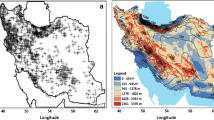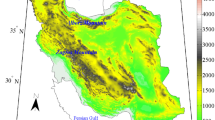Abstract
Investigation of the precipitation phenomenon as one of the most important meteorological factors directly affecting access to water resources is of paramount importance. In this study, the precipitation concentration index (PCI) was calculated using annual precipitation data from 34 synoptic stations of Iran over a 50-year period (1961–2010). The trend of precipitation and the PCI index were analyzed using the Mann–Kendall test after removing the effect of autocorrelation coefficients in annual and seasonal time scales. The results of zoning the studied index at annual time scale revealed that precipitation concentration follows a similar trend within two 25-year subscales. Furthermore, the PCI index in central and southern regions of the country, including the stations of Kerman, Bandarabbas, Yazd, Zahedan, Shahrekord, Birjand, Bushehr, Ahwaz, and Esfahan indicates a strong irregularity and high concentration in atmospheric precipitations. In annual time scale, none of the studied stations, had shown regular concentration (PCI < 10). Analyzing the trend of PCI index during the period of 1961–2010 witnessed an insignificant increasing (decreasing) trend in 16 (15) stations for winter season, respectively, while it faced a significant negative trend in Dezful, Saghez, and Hamedan stations. Similarly, in spring, Kerman and Ramsar stations exhibited a significant increasing trend in the PCI index, implying significant development of precipitation concentration irregularities in these two stations. In summer, Gorgan station showed a strong and significant irregularity for the PCI index and in autumn, Tabriz and Zahedan (Babolsar) stations experienced a significant increasing (decreasing) trend in the PCI index. At the annual time scale, 50 % of stations experienced an increasing trend in the PCI index. Investigating the changes in the precipitation trend also revealed that in annual time scale, about 58 % of the stations had a decreasing trend. In winter, which is the rainiest season in Iran, about 64 % of stations experienced a decreasing trend in precipitation that caused an increasing trend in PCI index. Comparing the spatial distribution of PCI index within two 25 years sub-periods indicated that the PCI index of the second sub-period increased in the spring time scale that means irregularity of precipitation distribution has been increased. But in the other seasons any significant variations were not observed. Also in the annual time scale the PCI index increased in the second sub-period because of the increasing trend of precipitation.













Similar content being viewed by others
Explore related subjects
Discover the latest articles and news from researchers in related subjects, suggested using machine learning.References
Adegun O, Balogun I, Adeaga O (2012) Precipitation concentration changes in Owerri and Enugu. Hydrol Disaster Manag Spec Publ Niger Assoc Hydrol Sci: 391–383
Alijani B, O’Brien J, Yarnal B (2008) Spatial analysis of precipitation intensity and concentration in Iran. Theor Appl Climatol 94:107–124
Asong ZE, Khaliq MN, Wheater HS (2015) Regionalization of precipitation characteristics in the Canadian Prairie Provinces using large-scale atmospheric covariates and geophysical attributes. Stoch Environ Res Risk Assess 29(3):875–892
Caloiero T (2014) Analysis of rainfall trend in New Zealand. Environ Earth Sci 73:6297–6310. doi:10.1007/s12665-014-3852-y
Chen J, Wub X, Finlayson B, Webber M, Wei T, Li M (2014) Variability and trend in the hydrology of the Yangtze River, China: annual precipitation and runoff. J Hydrol 513:403–412
Dinpashoh Y, Mirabbasi R, Jhajharia D, ZareAbianeh H, Mostafaeipour A (2014) Effect of short term and long-term persistence on identification of temporal trends. J Hydrol Eng 19(3):617–625
Duhan D, Pandy A (2013) Statistical analysis of long term spatial and temporal trends of precipitation during 1901–2002 at Madhya Pradesh, India. Atmos Res 122:136–149
Gozzini B, Bartolini G, Torrigiani T (2012) Precipitation concentration patterns in Tuscany (central Italy) 1955–2010. Euro Ann Meetings, vol. 9, EMS2012-339, 2012. 12th EMS/9th ECAC
Hamed KH, Rao AR (1998) A modified Mann-Kendall trend test for autocorrelated data. J Hydrol 204:182–196
Hirsch RM, Slack JR, Smith RA (1982) Techniques of trend analysis for monthly water quality data. Water Resour Res 18(1):107–121
Hosseinzadeh Talaee P, Kouchakzadeh M, Shifteh Some’e B (2014) Homogeneity analysis of precipitation series in Iran. Theor Appl Climatol 118:297–305. doi:10.1007/s00704-013-1074-y
Jain SK, Kumar V, Saharia M (2013) Analysis of rainfall and temperature trends in northeast India. Int J Climatol 33:968–978
Jhajharia D, Chattopadhyay S, Choudhary RR, Dev V, Singh VP, Lal S (2013) Influence of climate on incidences of malaria in the Thar Desert, northwest India. Int J Climatol 33:312–325
Jhajharia D, Dinpashoh Y, Kahya E, Choudhary RR, Singh VP (2014a) Trends in temperature over Godavari river basin in southern peninsular India. Int J Climatol 34(5):1369–1384
Jhajharia D, Kumar R, Dabral PP, Singh VP, Choudhary RR, Dinpashoh Y (2014b) Reference evapotranspiration under changing climate over the Thar Desert in India. Meteorol Appl. doi:10.1002/met.1471
Jiang T, Su B, Hartmann H (2007) Temporal and spatial trends of precipitation and River flow in the Yangtze River basin, 1961–2000. Geomorphology 85:143–154
Kendall MG (1975) Rank correlation measures. Charles Griffin, London
Khalili K (2014) Comparison of geostatistical methods for interpolation groundwater level (case study: Lake Urmia basin). J Appl Environ Biol Sci 4(1s):15–23
Khalili K, Nazeri Tahrudi M, Khanmohammadi N (2014) Trend analysis of precipitation in recent two decade over Iran. J Appl Environ Biol Sci 4(1s):5–10
Kousari MR, Ekhtesasi MR, Tazeh M, Saremi Naeini MA, Asadi Zarch MA (2011) An investigation of the Iranian climatic changes by considering the precipitation, temperature, and relative humidity parameters. Theor Appl Climatol 103:321–335
Kousari MR, Ahani H, Hendi-Zadeh R (2013) Temporal and spatial trend detection of maximum air temperature in Iran during 1960–2005. Global Planet Change 111:97–110
Kumar S, Merwade V, Kam J, Thurner K (2009) Stream flow trends in Indiana: effects of long term persistence, precipitation and subsurface drains. J Hydrol 374:171–183
Lenderink G, Meijgaard EV (2008) Increase in hourly precipitation extremes beyond expectations from temperature changes. Nat Geosci 1:511–514. doi:10.1038/ngeo262
Luis Mde, Gonz´alez-Hidalgo JC, Brunetti M, Longares LA (2011) Precipitation concentration changes in Spain 1946–2005. Nat Hazards Earth Syst Sci 11:1259–1265
Mann HB (1945) Nonparametric test against trend. Econometrica 13:245–259
Mirabbasi R, Anagnostou EN, Fakheri-Fard A, Dinpashoh Y, Eslamian S (2013) Analysis of meteorological drought in northwest Iran using the joint deficit index. J Hydrol 492:35–48. doi:10.1016/j.jhydrol.2013.04.019
Moradi Dashtpagerdi M, Kousari MR, Vagharfard H, Ghonchepour D, Esmaeilzadeh Hosseini M, Ahani H (2015) An investigation of drought magnitude trend during 1975–2005 in arid and semi-arid regions of Iran. Environ Earth Sci 73:1231–1244. doi:10.1007/s12665-014-3477-1
Oliver JE (1980) Monthly precipitation distribution: a comparative index. Prof Geogr 32:300–309
Pal Al-Tabbaa A (2009) Trends in seasonal precipitation extremes—an indicator of ‘climate change’ in Kerala, India. J Hydrol 367:62–69
Saboohi R, Soltani S, Khodagholi M (2012) Trend analysis of temperature parameters in Iran. Theor Appl Climatol 109:529–547
Seyyedi H, Anagnostou EN, Kirstetter PE, Maggioni V, Hong Y, Gourley JJ (2014) Incorporating surface soil moisture information in error modeling of TRMM passive Microwave rainfall. IEEE Trans Geosci Remote Sens 52(10):6226–6240
Some’e BS, Ezani A, Tabari H (2012) Spatiotemporal trends and change point of precipitation in Iran. Atmos Res 113:1–12
Tabari H, Hosseinzadeh Talaee P (2011a) Analysis trends in temperature data in arid and semi-arid regions of Iran. Atmos Res 79:1–10
Tabari H, Hosseinzadeh Talaee P (2011b) Temporal variability of precipitation over Iran: 1966–2005. J Hydrol 396(3–4):313–320
Tabari H, Marofi S, Aeini A, Talaee PH, Mohammadi K (2011a) Trend analysis of reference evapotranspiration in the western half of Iran. Agric For Meteorol 151(2):128–136
Tabari H, Shifteh Somee B, Rezaeian Zadeh M (2011b) Testing for long-term trends in climatic variables in Iran. Atmos Res 100(1):132–140
Valli M, Sree KS, Krishna IVM (2013) Analysis of precipitation concentration index and rainfall prediction in various agro-climatic zones of Andhra Pradesh, India. Int Res J Environ Sci 2(5):53–61
Yang XL, Xu LR, Li Ch, Hu J, Xia XH (2012) Trends in temperature and precipitation in the Zhangweinan River basin during last 53 years. Proced Environ Sci 13:1966–1974
Zarenistanak M, Dhorde AG, Kripalani RH (2014) Temperature analysis over southwest Iran: trends and projections. Theor Appl Climatol 116(2):103–117
Zhang Q, Xu CY, Tao H, Jiang T, Chen YD (2010) Climate changes and their impacts on water resources in the arid regions: a case study of the Tarim River basin, China. Stoch Environ Res Risk Assess 24(3):349–358
Author information
Authors and Affiliations
Corresponding author
Rights and permissions
About this article
Cite this article
Khalili, K., Tahoudi, M.N., Mirabbasi, R. et al. Investigation of spatial and temporal variability of precipitation in Iran over the last half century. Stoch Environ Res Risk Assess 30, 1205–1221 (2016). https://doi.org/10.1007/s00477-015-1095-4
Published:
Issue Date:
DOI: https://doi.org/10.1007/s00477-015-1095-4
Keywords
Profiles
- Rasoul Mirabbasi View author profile




